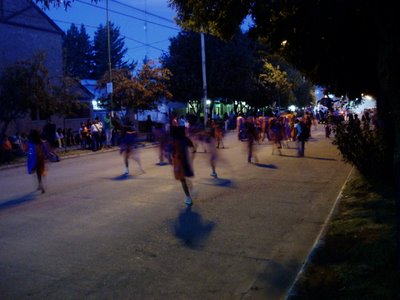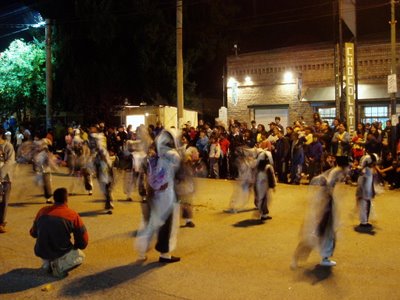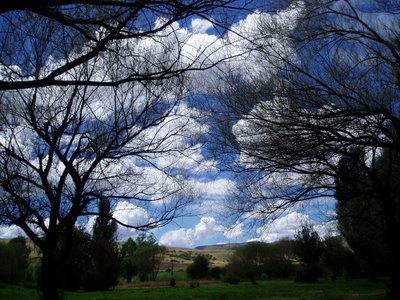Patagonia: Junin de los Andes (Feb. 22-25, 2006)
I almost forgot about the whole Patagonia thing.
My first stop was at a small town in Neuquén province called Junin de los Andes, sister town of the more popular - but more expensive and touristy - town to the south, San Martin de los Andes. JdlA is more in what's called the Lake District as opposed to Patagonia, and as it turns out, the area is quite charming and scenic, as the name would suggest. I woke up a little too late on my first morning to get to the hiking, as the buses departed for Parque Nacional Lanín at 10:00am, and I was far too tired to make that particular deadline. Instead I had quite a nice day wandering around the town, taking in the scenery and a long lunch, and appreciating the very odd but very compelling monkey puzzle trees.
It was easy to forget, at that point, that I my arrival in JdlA had been in a perpetual state of jeopardy. I don't remember the Argentine bus system as confusing and inefficient - habitually tardy and inveterate loiterers, even in the most avoidable of places - but perhaps that's because it was Scott's job to be concerned with such things when last I visited. The delay that was out of the bus company's control, to be fair, was a storm that descended on Buenos Aires right at 8:00pm as we were leaving. I wasn't in a mood to make excuses for these people, however, as they had managed to roll into Retiro (the bus station) only two minutes before departure time, and in the wrong spot. Running along the line of 70+ buses, dodging people, looking at the useless departures board, trying not to panic; that I actually do remember from my last visit.
So the roads out of Buenos Aires were frequently covered in water, the surface of which sometimes reached a car's rim, and sometimes its bumper. The going was slow. I wondered, as we finally arrived at Neuquén at 3:15pm the next day, more than 2.5 hours late, if 12:30pm was a realistic arrival time even in the absence of the storm. We stuck around at the most apparently insignificant bus stations for at least 15 minutes, waiting for no one to get on or off, and of course every time the bus pulled into one of the carbon-copy bus satations I had to ask "Estamos en Neuquén?" We weren't.
But I had stopped worrying about all this entirely by the time I was sat down at a cafe along the Plaza San Martin, chatting with a field biologist from Banff who had come down south for a break before returning to study a salamander with a distinctive yellow stripe down its back, the name of which eludes me. One frequently meets people down here whose conversation is, if nothing else, unpredictable. I suppose we thought something might be up when a large paper maché lizard ambled down the street, carried by about eight kids, just as the sun was setting; we knew for sure that this was not an ordinary night when a group of forty-odd kids gathered in the middle of the Plaza San Martin to rehearse an impressive display of drumming and dancing. I was pretty far away from the action for South America, but even still, it was February 24, the beginning of Carnivale.
For a town that could not have had more than 5,000 inhabitants, Junin de los Andes deserves quite a bit of credit for the show they put on that night. The parade consisted of three separate groups of drummers, maybe ten of them, with dancers, maybe twenty, who all performed a few basic sways, spins, and kicks, all to the same fairly elaborate drum beats. All of the dancers and most of the drummers were kids, mostly under the age of twelve. In between these groups were rather odd floats: a bulldozer, an F1 racing car, the lizard from before that took repeated runs at the kids on the sidewalk, just stopping short (though eliciting a few surprised screams), and a cigarette with the word "Neuquén" printed around the filter. I'm still a little puzzled by that last one. Quite a spectacle.
The most surprising thing about the parade was its length. Not that the parade route itself was long, as it covered most of the town's main drag, about four blocks. After the groups reached the end though, they did a little cheer, and then went right back to the start, and did it again. The going was slow, so each trip took at least forty-five minutes. I went to bed when they were on the third lap. Between the parade and their extended warm-up beforehand, those kids must have been dancing for hours. Props.
I missed the bus again the next day - not because I woke up late, but because it was all booked up - so I had decided that I had spent just enough time in Junin de los Andes. It was a lovely time, and I enjoyed myself, but I had hiking to do, and the town had served its purpose of breaking up the trip nicely. Next up: El Bolsón, a town that I had, on impulse, decided to visit in favour of the more popular Bariloche. Just a few days there, I told myself, and then onto Patagonia proper. Just goes to show the futility of planning.

Getting lined up for the parade.

Rolling down the main drag.

More dancers.

Just before leaving Junin. Pretty.

0 Comments:
Post a Comment
<< Home